Air conditioner thermostat
The brain behind air conditioner units
How does a thermostat work?
Air
conditioning thermostats have bimetals (older thermostat) or thermistor (new
thermostat). These bimetals or thermistor sense the air current returning to
the return ducts or the surrounding air.
The
basic operation principle of air conditioning thermostat is it relies on random
air current that passing thought it to determine the room temperature. It uses
room temperature to compare with the setpoint temperature.
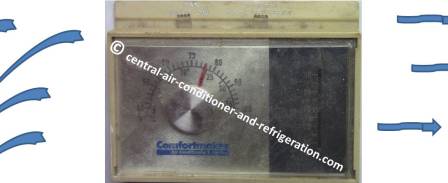
Ex. We
are in heat mode and we set the temperature at 70°F. Let’s said the air
conditioning thermostat senses the random air current and the air current
temperature is 65°F.
All HVAC thermostat works on this principle. It doesn’t matter if it digital, programmable, talking thermostat, telephone thermostats or zoning thermostat. It will rely on air current to works.
What is air conditioner thermostat?
AC thermostat is the device that controls the air conditioner units. It uses to turn the heater or AC unit ON and OFF. Hvac thermostat is a temperature controls. It controls the temperature of specific building.
The hvac thermostat we’ll being discussion here is a room thermostat. This air conditioning thermostat controls space temperature for comfort purposes.
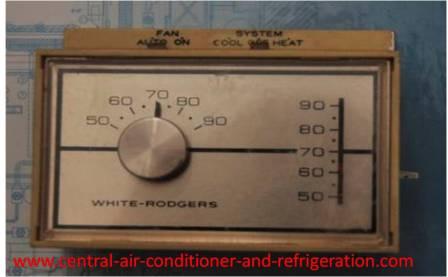
The
space temperature thermostat is mounted 5 feet above floor level and it’s on
the wall. The location where to mount the air conditioner thermostat is
significant. It can’t expose direction to sunlight or heat or cold object.
The room
thermostat we’ll discuss here is a regular mercury thermostat. The mercury thermostats
are use a lot on older central air conditioner. This regular mercury
thermostat doesn’t apply to Heat Pump.
There’re normally three parts to home thermostat:
- The thermostat cover
- The thermostat assembly
- The subbase
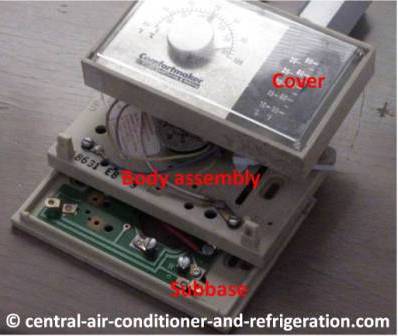
Air conditioner thermostat cover
The thermostat cover doesn’t do much, except it has a thermometer that mounted on it to read the space (surrounding air) temperature. This thermometer is made of bimetal strip not mercury. The bimetal strip is sensor that makes of two different types of metal that bonded together as one metal.
The other purpose of thermostat cover is to protect the thermostat assembly from being damage by children or accidentally knocking on it.
AC thermostat assembly
The air conditioning thermostat assembly is the brain of the thermostat. The assembly has an adjustment lever to increase or decrease the room temperature.

The AC thermostat assembly has the basic components:
- Heat anticipator
- Cold anticipator (cooling season)
- The bimetal sensor
- Mercury bulb
Heat Anticipate – what is it?
In AC thermostat there this small resistor calls heat anticipator or cooling anticipator. This heat anticipator is adjustable and located right on the bimetal sensing coils. Its use mainly to cut the heating unit early before it reaches the setpoint temperature.
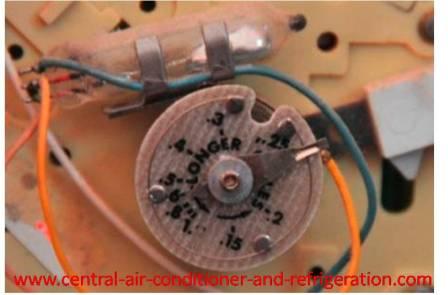
Air conditioner thermostat terms:
- Setpoint temperature – its the temperature at which a thermostat wills cut-OFF. The setpoint is the temperature you set at your thermostat for your heater or cooling units.
- For example: We’re in heated mode and we turn the thermostat adjustment lever to 70°F. The setpoint would be 70°F (it’s the temperature we set our thermostat at). The setpoint is known as the cut- off point.
- Temperature adjustment lever – this is a small handler we used to set or turn the temperature. This lever is inside the thermostat assembly. This adjustment lever also known as setpoint adjustor or selector switching lever.
The adjustment lever is mounted on a pivot inside the thermostat assembly. It rotates left or right to increase and decrease the room temperature.
The heat
anticipator is a resistor that given off small amount of heat to the bimetal.
This small amount of heat prevents the temperature from rising above the
thermostat setpoint.
The heat anticipator is located inside the air conditioner thermostat and mounts on the bimetal sensing coils. The bimetal coils is warmer than the room temperature due to the resistor. It causes the furnace to cut off early. As the furnace is off the blower will run to dissipate the heat from the furnace.
For example: We’re in heat mode. We set the thermostat to 70°F. The heat anticipator will cut – OFF the furnace at 68°F and allow the blower to run until it removes the heat in the furnace to reach the setpoint.
Bimetal strip acts as thermometer
The mercury thermostat has a bimetal strip that acts as thermometer to tell the central air units to run or not. These bimetal strips are commonly used brass and steel as the metal. These two metals are laminated or bonding together. We could said it attach back to back as one metal.
This metal strip is use to sense the temperature of the surrounding air nears the air conditioner thermostat. Each metal react differently to hot and cold air and each metal expand and contract at different rate.
However, one metal has a high rate of expansion and contraction while the other metal has low rate of expansion and contraction.
This is how bimetal reacted to temperature. We have the brass and steel as the bimetal materials. Brass and steel expand and contract at different rate and temperature. If we were to cool the bimetal with ice, it would contract and if we’ve to heat the bimetal it would expand.
How long in distance the bimetal expand and contract depends on the length of the bimetal. If it were short it would be difficult to expand and contract.
This bimetal strip in a mercury thermostat is coiled into a circle. The bimetal has the two ends. One end of the circle is attached to mercury bulb switches and the other end is in a pivot with temperature adjustment lever.
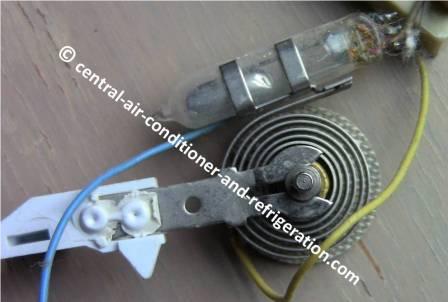
Thermostat mercury Switch
Mercury was used in the earlier thermostat to make and break the electric circuit in a 24 volt thermostat.
Mercury is a poisonous atom to people. The earlier or older air conditioner thermostat will have the mercury in it. The reason they used mercury in AC thermostat is because it conducts electricity and in liquid state.
The mercury is inside small glass. This glass bulb is filled with inert gas and had a small drop of mercury in it. The mercury is freely to move from one location of the glass bulb to other end.
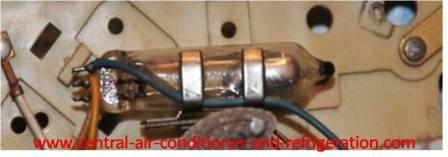
The mercury bulb has thin wires inside it. There are three wires within the mercury bulb. The three thermostat wires that are attach to the mercury bulb is in vertical position.
The
first thin wire goes across all the way to the other end of the mercury bulb
and the mercury is always in contact with this wire. However, this wire is insulating
within the mercury bulb and only the short tip is not insulated. The short bare
wire tips what cause the mercury to make contract with.
This thin thermostat wire is to adjust the temperature of cooling mode. It connective or screw to Y terminal of the air conditioner thermostat subbase and it’s also attach to one end of the cool anticipate.
The second thin wire is short and near the beginning. It’s in the middle of the first and the third wire in vertical position. This second wire from mercury bulb is permanent attach to heating anticipate.
The
third wire also goes across to the end of the mercury bulb and it’s in the
bottom wire. This wire is not insulating as the first (cooling wire). This wire
is explored and always remains in contact with the mercury.
This wire is screw to W terminal of the air conditioner thermostat subbase and it’s also attach to the other end of the cooling anticipate. The cooling anticipates is in the back of the Ac thermostat assembly. It’s a resistor.
The idea behind a thin electrical wire within mercury bulb is to make and break electrical current easily and doesn’t have weight on the bimetal coils. A wire within a mercury bulb is another form of contractor.
When electrical
wires within the mercury contact each other, there is an arc occur within the
mercury bulb. This arc is hot enough to cause oxidation within the mercury
bulb. However, due to mercury and the arc within close location, it won’t
burn.
The mercury bulb is attaching to the movable end of the bimetal coils and the other end of the bimetal is fastened to the stationary pivot with temperature adjustment lever.
The movable
end of the mercury bulb is freely to rotate with the bimetal coils. When the
bimetal move, it tips the bulb and the mercury with the bulb move to the other
end of the bulb and provides a path for the current to flows from wire within
the bulb.
Air conditioner thermostat subbase
The air conditioning thermostat subbase is the last component. The subbase is the first component that must mount on the wall.
Air conditioning thermostat subbase has two selector switch levers:
- The first selectors switch is to turn FAN ON or AUTO.
The second selectors switch is to turn air conditioner units to COOL - OFF - HEAT.
This known as mode. Ex. Cool Mode or Heat Mode.
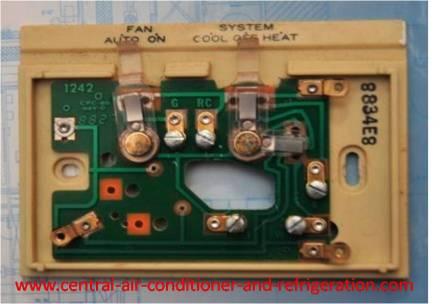
This AC thermostat subbase selector switching is not for Heat Pump thermostat. Heat pump has the extra switching went comparing to regular air conditioner and heating units.
Air conditioner thermostat subbase has field wire connector from the air conditioner, heating, fan, and power wire.
These
wires are color coded in white, yellow, green, and red. It also has label on
it.
- Red wire is the power sources from transformer. This wire is 24 volt. You will connect this wire to RH terminal. There should be jumper between RH and RC terminal.
- Green wire is the wire that comes from relay and it controls the fan. You connect to G terminal in the AC thermostat subbase.
- Yellow wire is for control of the air conditioner units. You connect yellow wire to Y terminal on the thermostat subbase.
White wire is to the thermostat subbase W terminal. This thermostat wire is for heating unit (furnace).
This is the basic thermostat wire we need to run a fan, furnace, and central air conditioning unit with mercury thermostat or programmable thermostat with battery. This thermostat wire is just the basic wire; there are thermostats that need 5 wires or more wires to operate air conditioner units.
Types of air conditioning thermostat:
- Regular old AC thermostat (mercury)
- Digital thermostats
- Talking thermostats
- Telephone thermostats
- System zoning thermostat (for individual room)
- Heat Pump thermostats – thermostat for heat pump only.
Electronic thermostat
Where to install a thermostat?
After reading this, we probably know how thermostats work, how to wire a thermostat and how to change thermostat. However, known all this information is good, but we need to know where to install an air conditioner thermostat.
In a residential ac units, the best location is the hall. The hall is usually the best place for the ac thermostat to read the air current correctly.
The thermostat has to mount about 5 feet above floor level and it has to be 18 inch from outside wall.
Air conditioner thermostat should not mount on:
- Outside wall
- Closet
- Behind door
- Near any window that could be hit by sunlight.
- Near hot or cold object.
Learn more on:
How to wire a thermostat and color coded
Return to central air conditioner and refrigeration